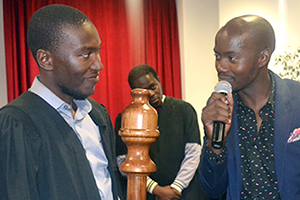Democracy and political tolerance truly thrive during Qwaqwa Campus SRC elections

The newly-elected SRC President of the Qwaqwa
Campus, Njabulo Mwali (left), being congratulated
by his predecessor, Paseka Sikhosana.
Photo: Thabiso Gamede
Voter turnout during the recent SRC elections among the best in the country at over 60%
The 2016-2017 Qwaqwa Campus SRC elections have once again proven that democracy and political tolerance are truly thriving on the Qwaqwa Campus. This was evidenced by the calm surrounding the highly contested elections ever.
According to Mandla Ndlangamandla, Electoral Committee Chairperson, this year’s elections were highly contentious, yet with a high level of tolerance.
"We only had two political structures, namely the South African Democratic Student Movement (Sadesmo) and the South African Student Congress (Sasco), but the level of engagement was really commendable,” he said.
“Of the 4 200 registered students on campus, more than 2 500 cast their votes in their quest to influence student leadership and governance to advance student aspirations," said Ndlangamandla during the handover ceremony.
In accepting the leadership baton from his predecessor, Paseka Sikhosana, the new President, Njabulo Mwali, said his immediate goal was to unite all students behind the new leadership.
In acknowledging the role student governance can play in developing the campus, the Acting Campus Principal, Teboho Manchu, said the campus was proud to have a student leadership that would always keep the interests of their constituency on top of their agenda.
“We will definitely work hand-in-hand with the new student government. In case of any disagreements, please note that you have the right to take up any such matters with the top management of the university in order to advance the entire student body,” he added.
The 2016-2017 Qwaqwa Campus SRC is as follows:
LIST OF SRC MEMBERS 2016-2017
Elective Portfolios |
|
Name and Surname |
Portfolio |
Njabulo Mwali |
President General |
Siyabonga Ngubo |
Deputy President |
Joy Mapule Motloung |
Secretary General |
Bongela Nyandeni |
Treasurer General |
Mpumelelo Tshabalala |
Politics and Transformation |
Nomcebo Mqushulu |
Media and Publicity |
Ntokozo Michael Masiteng |
Student Development and Environmental Affairs |
| |
|
Ex Officio Portfolios |
|
Khulani Mhlongo |
Arts and Culture |
Polaki Mazibuko |
Academic Affairs |
Ntokozo Mbali Thango |
Sports Affairs |
Motlatsi Lisley Lebona |
Religious Affairs |
Sandile Ntamane |
Residence Affairs |
Itumeleng Chefter |
RAG Comm. and Dialogue |
Thulebona Thomas Khumalo |
Off-campus |